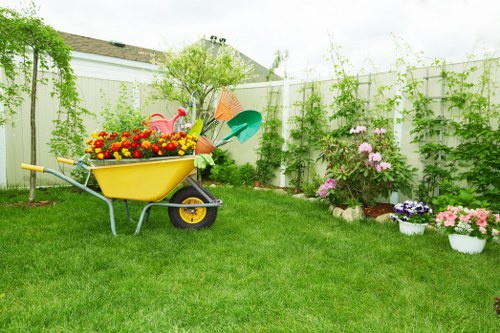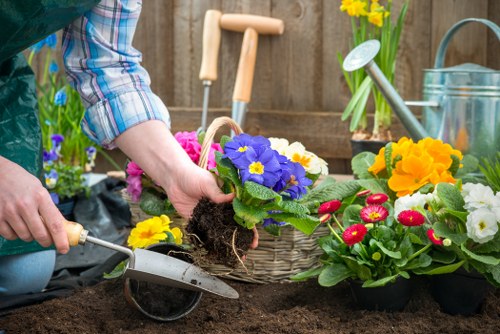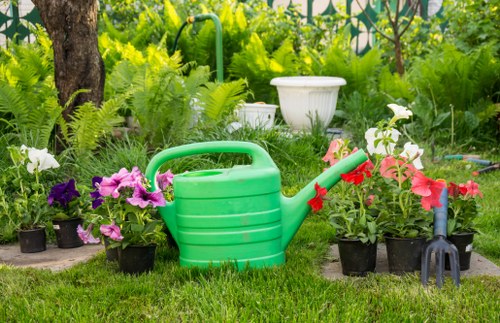Garden Clearance in Temple: Ensuring a Sacred and Serene Environment
Introduction to Garden Clearance in Temples

Maintaining the sanctity and beauty of temple gardens is paramount for preserving the spiritual ambiance that worshippers seek. Garden clearance in temples involves meticulous planning and execution to ensure that the sacred spaces remain pristine, welcoming, and conducive to meditation and prayer.
Over time, gardens can accumulate debris, overgrown vegetation, and clutter that detract from their intended purpose. Regular clearance not only enhances the aesthetic appeal but also contributes to the overall health of the garden ecosystem.
In this article, we will explore the comprehensive process of garden clearance in temples, the benefits it brings, and how to effectively implement it to maintain a harmonious environment.
Why Is Garden Clearance Important in Temples?

Temples are places of worship, reflection, and community gatherings. The gardens surrounding these sacred buildings play a crucial role in creating a tranquil atmosphere that supports these activities.
Here are several reasons why garden clearance is essential in temple settings:
- Aesthetic Appeal: A well-maintained garden enhances the visual appeal of the temple, making it more inviting for visitors.
- Spiritual Significance: Clean and orderly gardens reflect the spiritual purity and discipline upheld by the temple community.
- Health and Safety: Removing debris and overgrown plants reduces the risk of accidents and promotes a healthier environment.
- Environmental Benefits: Proper clearance supports plant health, prevents pest infestations, and maintains biodiversity.
Understanding these benefits underscores the importance of regular garden clearance in maintaining the sanctity and functionality of temple grounds.
Steps Involved in Garden Clearance

Effective garden clearance in temples involves a systematic approach to ensure that no aspect is overlooked. Below are the key steps involved in the process:
- Assessment: Evaluate the current state of the garden to identify areas that need attention. This includes assessing plant health, identifying invasive species, and noting any structural elements that require maintenance.
- Planning: Develop a clearance plan that outlines the tasks to be performed, the resources needed, and the timeline for completion. This ensures that the process is organized and efficient.
- Removal of Debris: Clear the garden of fallen leaves, branches, and any other debris that has accumulated. This step is crucial for maintaining cleanliness and preventing pest infestations.
- Pruning and Trimming: Trim overgrown plants and bushes to promote healthy growth and maintain the desired shape and size of the vegetation.
- Weed Control: Remove unwanted weeds that compete with desirable plants for nutrients and space. This helps in sustaining the overall health of the garden.
- Disposal: Properly dispose of the cleared materials, ensuring that the garden remains tidy and free from clutter.
Following these steps ensures a thorough and effective garden clearance that upholds the temple's standards of beauty and serenity.
Tools and Equipment for Effective Garden Clearance

Having the right tools and equipment is essential for efficient garden clearance. The following tools are commonly used in temple garden maintenance:
- Pruning Shears: For trimming and shaping plants and shrubs.
- Loppers: Useful for cutting thicker branches that pruning shears cannot handle.
- Leaf Blowers: To quickly remove fallen leaves and light debris from pathways and lawn areas.
- Rakes: For gathering leaves, grass clippings, and other loose materials.
- Weeders: To effectively remove weeds from flower beds and other planted areas.
- Wheelbarrows: For transporting large quantities of debris and waste materials.
Investing in quality tools not only makes the clearance process more efficient but also ensures that the garden is maintained to the highest standards.
Best Practices for Sustainable Garden Clearance

Sustainability should be a key consideration in garden clearance activities. Implementing eco-friendly practices helps in preserving the environment and promotes long-term garden health.
Here are some best practices to adopt:
- Composting: Instead of disposing of garden waste in landfills, consider composting. Composting recycles organic matter into valuable fertilizer for the garden.
- Selective Pruning: Focus on pruning to promote plant health rather than indiscriminate cutting, which can harm the vegetation.
- Use of Eco-Friendly Tools: Opt for tools that are energy-efficient and made from sustainable materials.
- Water Management: Ensure that garden clearance activities do not disrupt the natural water flow, preventing erosion and waterlogging.
- Native Plants: Promote the use of native plant species that are well-suited to the local climate and require less maintenance.
Adhering to these sustainable practices ensures that garden clearance contributes positively to the temple's environment and community.
Seasonal Garden Clearance Tips
Different seasons present unique challenges and opportunities for garden clearance in temples. Adapting your clearance practices to the changing seasons can enhance the effectiveness of your maintenance efforts.
Spring Clearance
Spring is an ideal time to perform a thorough garden clearance after the winter months. Focus on:
- Removing Winter Debris: Clear away dead leaves, branches, and other debris accumulated during winter.
- Pruning: Trim back any overgrown plants to encourage healthy new growth.
- Soil Preparation: Prepare the soil for planting new flowers and shrubs by adding compost or fertilizers.
Summer Maintenance
During the summer, maintaining adequate moisture levels and controlling pests are paramount. Focus on:
- Regular Watering: Ensure that plants receive sufficient water, especially during dry spells.
- Mulching: Apply mulch to retain soil moisture and suppress weed growth.
- Pest Control: Monitor for and address any pest infestations promptly.
Autumn Cleanup
Autumn brings fallen leaves and prepares the garden for winter. Key tasks include:
- Leaf Removal: Clear fallen leaves to prevent mold and pest problems.
- Planting: Plant bulbs and perennials that will thrive in the upcoming spring.
- Final Pruning: Perform last-minute pruning to shape plants before winter.
Winter Preparations
Winter requires special care to protect plants and maintain garden structure. Focus on:
- Protective Covering: Use burlap or frost cloths to protect sensitive plants from harsh weather.
- Tool Maintenance: Clean and store garden tools properly to extend their lifespan.
- Planning: Plan for the next year's garden clearance and landscaping activities.
By tailoring your garden clearance efforts to the seasons, you can ensure year-round maintenance and beauty of the temple gardens.
Choosing Professional Services for Garden Clearance
While some temples may have dedicated gardening staff, others might benefit from hiring professional garden clearance services. Professionals bring expertise, efficiency, and specialized equipment to ensure thorough and effective clearance.
Benefits of Hiring Professionals
There are several advantages to engaging professional garden clearance services:
- Expertise: Professionals possess knowledge of plant biology, soil science, and effective clearance techniques.
- Efficiency: Experienced teams can complete tasks more quickly and accurately.
- Specialized Equipment: Access to high-quality tools and machinery that may not be available in-house.
- Safety: Professionals are trained to handle potentially hazardous tasks safely.
- Customized Services: Tailored clearance plans that meet the specific needs of the temple gardens.
Choosing a reputable service provider ensures that the garden clearance is performed to the highest standards, preserving the temple's sacred environment.
Factors to Consider When Selecting a Service Provider
When selecting a professional garden clearance service for your temple, consider the following factors:
- Experience: Choose a company with a proven track record in garden maintenance and clearance.
- Reputation: Look for reviews, testimonials, and references to gauge the quality of their services.
- Services Offered: Ensure that the provider offers comprehensive clearance services tailored to your needs.
- Pricing: Compare pricing structures to find a service that offers good value without compromising quality.
- Insurance and Licensing: Verify that the company is properly insured and licensed to perform garden clearance work.
By carefully evaluating these factors, you can select a reliable and efficient garden clearance service that aligns with your temple's requirements.
Maintaining the Cleared Garden
Garden clearance is not a one-time task but an ongoing process that requires regular maintenance to sustain the desired environment. Here are some tips for maintaining a cleaned and orderly temple garden:
Regular Inspections
Conduct routine inspections to identify any new clutter, overgrowth, or maintenance issues. Early detection allows for timely intervention.
Scheduled Maintenance
Establish a maintenance schedule that includes tasks such as weeding, pruning, mowing, and debris removal. Consistent upkeep prevents the garden from becoming unruly.
Community Involvement
Encourage temple members and visitors to participate in maintaining the garden. Community involvement fosters a sense of ownership and responsibility.
Proper Waste Management
Implement effective waste management practices, such as composting organic waste and recycling materials, to keep the garden clean and sustainable.
Seasonal Adjustments
Adapt maintenance activities to the changing seasons, ensuring that the garden remains healthy and beautiful throughout the year.
By adhering to these maintenance practices, your temple garden will continue to be a serene and inviting space for worship and reflection.
Common Challenges in Garden Clearance and How to Overcome Them
While garden clearance is essential, it can present several challenges, especially in the context of temple gardens. Understanding these challenges and implementing strategies to overcome them ensures successful maintenance.
Dealing with Overgrown Vegetation
Overgrown plants can obscure pathways, hinder visibility, and threaten the health of other plants. To manage overgrowth:
- Regular Pruning: Schedule frequent pruning sessions to keep vegetation in check.
- Selective Planting: Choose plant species that do not grow too aggressively and require minimal pruning.
- Use of Mulch: Apply mulch to suppress unwanted growth and maintain soil health.
Managing Invasive Species
Invasive plants can disrupt the garden's ecosystem, outcompeting native species and reducing biodiversity. Effective management includes:
- Identification: Accurately identify invasive species present in the garden.
- Controlled Removal: Remove invasive plants carefully to prevent their spread.
- Restoration: Replant native species to restore the garden's natural balance.
Ensuring Safety
Garden clearance involves physical labor that can pose safety risks. To ensure the safety of those involved:
- Use Protective Gear: Equip workers with gloves, safety glasses, and other necessary protective equipment.
- Training: Provide training on the proper use of tools and safe working practices.
- Regular Breaks: Encourage regular breaks to prevent fatigue and reduce the risk of accidents.
Addressing these challenges proactively ensures that garden clearance activities are effective, safe, and sustainable.
Balancing Aesthetics and Functionality
Maintaining a balance between aesthetic appeal and functional use of the garden can be challenging. To achieve this balance:
- Design Planning: Incorporate both beauty and functionality in garden design plans.
- Functional Areas: Designate specific areas for meditation, gatherings, and other activities.
- Flexible Maintenance: Adapt maintenance practices to enhance both the visual and practical aspects of the garden.
By carefully planning and implementing garden clearance activities, temples can create spaces that are both beautiful and functional.
Conclusion
Embracing the Importance of Garden Clearance
Garden clearance in temples is more than just a maintenance task; it is a vital practice that upholds the sacredness and tranquility of worship spaces. By ensuring that temple gardens are clean, orderly, and beautiful, garden clearance supports the spiritual well-being of the community.
Implementing effective garden clearance strategies involves understanding the unique needs of temple gardens, using the right tools and techniques, and maintaining a commitment to sustainability and safety. Whether managed in-house or by professional services, regular clearance is essential for preserving the harmony and serenity that temples are meant to embody.
We encourage temple administrators and community members to prioritize garden clearance as part of their ongoing efforts to maintain and enhance these sacred spaces.
Take Action Today
Ready to transform your temple garden into a serene and welcoming space? Contact us today to schedule your garden clearance service and experience the difference professional maintenance can make.
Book Your Service Now
Don't wait to create a beautiful and peaceful environment for your worshippers. Book your garden clearance service now and take the first step towards a more harmonious temple garden.

